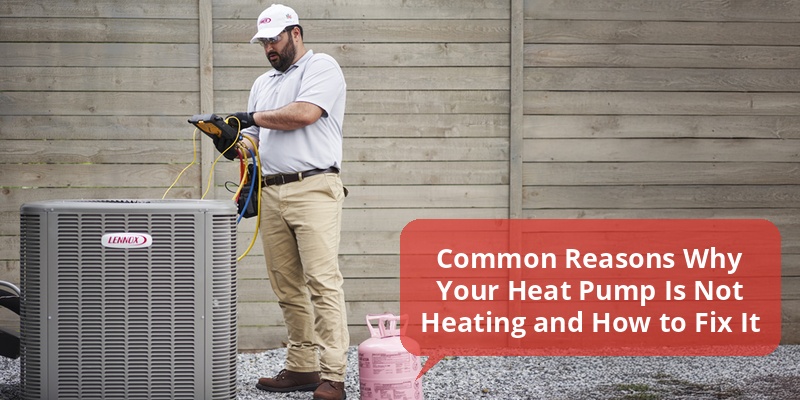Heat pumps are an energy-efficient option for heating and cooling homes, but sometimes they can fail to provide adequate warmth. When a heat pump is not heating properly, it can be due to various mechanical, electrical, or maintenance issues. Understanding these common problems can help homeowners diagnose the issue and decide whether to troubleshoot or call a professional.
| Cause | Description | Potential Solution |
|---|---|---|
| Thermostat Issues | Incorrect settings or malfunctioning thermostat can prevent heat pump activation. | Check and reset thermostat settings; replace if faulty. |
| Refrigerant Leak | Low refrigerant levels reduce heat transfer, impairing heating performance. | Locate and repair leaks; recharge refrigerant. |
| Dirty or Blocked Air Filters | Restricted airflow reduces system efficiency. | Clean or replace air filters regularly. |
| Defrost Cycle Problems | Heat pump may freeze up, cutting off heating. | Inspect defrost controls; repair sensors or controls. |
| Faulty Components | Malfunctioning compressors, fans, or reversing valves reduce heat output. | Professional inspection and part replacement needed. |
| Electrical Issues | Blown fuses, tripped breakers, or wiring problems stop operation. | Check power supply; reset breakers; consult technician for wiring issues. |
How Heat Pumps Work and Why They Sometimes Fail to Heat
Heat pumps transfer thermal energy from outside to inside your home by reversing the refrigeration cycle. They rely on components like compressors, fans, and refrigerants to move heat efficiently. However, when any part malfunctions or external factors interfere, the heating capacity diminishes.
Cold climates can challenge heat pump performance by causing frost buildup on outdoor coils, leading to a need for a defrost cycle. Without proper defrosting mechanisms, the system may stop providing heat altogether.
Thermostat and Control Settings
Improper thermostat settings are a common cause of heating issues. The thermostat must be set to “heat” mode and the temperature higher than the current room temperature. Additionally, a faulty or outdated thermostat can send incorrect signals, preventing the heat pump from activating properly.
Check that the thermostat is programmed correctly for seasonal use and, if it’s battery-powered, ensure batteries are fresh. Upgrading to a smart thermostat may improve system performance and energy efficiency.
Refrigerant Levels and Leaks
The refrigerant is vital for heat transfer in heat pumps. Low refrigerant levels often indicate leaks, which reduce heating effectiveness drastically. Signs of insufficient refrigerant include ice buildup on coils and lack of warm air output.
Since refrigerants require certified handling, any leak repair and recharge should be performed by a licensed HVAC technician. Regular system inspections can identify leaks early to prevent more extensive damage.
Airflow Restrictions from Dirty Filters and Coils
Dirty or clogged air filters and coils can severely hinder a heat pump’s ability to transfer heat. Restricted airflow forces the system to work harder, reduces efficiency, and can cause it to stop heating. Replacing air filters every 1-3 months and cleaning coils annually is critical maintenance.
Check evaporator and condenser coils for dirt or debris buildup. Cleaning these components promotes proper heat exchange and consistent indoor warmth.
Defrost Cycle Errors and Ice Buildup
Heat pumps periodically enter a defrost cycle to melt frost accumulated on the outdoor coil in cold weather. If defrost controls malfunction, ice buildup can block air movement and freeze system parts, stopping the heat pump from heating effectively.
Defrost sensors and timers should be inspected for faults. Sometimes, simply resetting the system can clear a stuck defrost cycle, but persistent issues require professional diagnostics.
Mechanical Failures in Key Components
The performance of compressors, reversing valves, fans, and motors is critical. Failures in these components directly reduce heating capacity or stop heat production. For example, a broken reversing valve can prevent the system from switching to heating mode.
Regular maintenance contracts often include checks for wear and tear that can prevent sudden heat pump breakdowns. Immediate professional repair is necessary if mechanical parts fail.
Electrical Problems and Power Supply
Electrical interruptions caused by blown fuses, circuit breaker trips, or faulty wiring can render the heat pump non-functional. Ensuring stable power supply and proper electrical connections is essential for continuous operation.
Reset breakers after power surges and inspect outdoor disconnect switches. If the heat pump still does not start, consult a licensed electrician or HVAC specialist.
When to Call a Professional Technician
While homeowners can resolve simple issues like thermostat settings and filter changes, many heat pump problems require professional intervention. Refrigerant leaks, electrical faults, mechanical failures, and defrost cycle malfunctions often need specialized tools and expertise.
Professional HVAC technicians can conduct thorough diagnostics, perform safe refrigerant handling, replace defective components, and optimize system settings, ensuring the heat pump operates efficiently and reliably.
Preventive Maintenance to Keep Your Heat Pump Heating Efficiently
Regular maintenance reduces the chance of heat pump failures and extends the unit’s lifespan. Key practices include:
- Replacing or cleaning air filters every 1-3 months
- Inspecting and cleaning coils annually
- Checking refrigerant levels annually
- Testing defrost controls before the heating season
- Scheduling professional tune-ups yearly
- Clearing debris and snow away from the outdoor unit
Implementing these steps improves heating efficiency and reduces unexpected breakdowns during cold weather.
